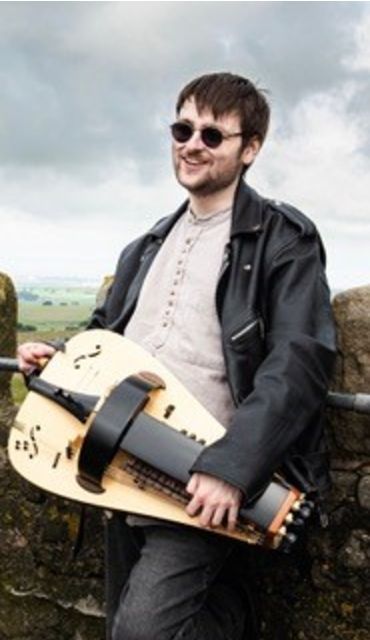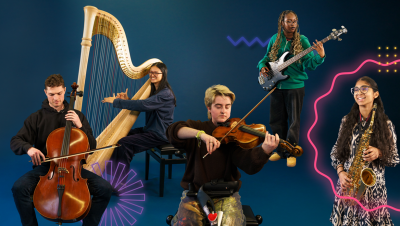

In conversation with Oliver
The National Open Youth Orchestra (NOYO) is a pioneering inclusive orchestra where brilliant 11-25 year-old disabled and non-disabled musicians rehearse and perform together.
The 2025 NOYO concert series kicks off in Milton Court Concert Hall on Sunday 27 April, as sixteen brilliant young musicians come together to present a broad programme of music commissioned for a mix of acoustic and electronic instruments, including a performance of the work Barriers by composer and past orchestra member, Oliver Cross.
We caught up with Oliver to hear more about the piece, and the important role played by NOYO in his development as a composer and musician.
In conversation with Georgina
Can you tell us a bit about yourself and your musical practice?
I grew up in Cambridge and am currently based in Lancashire. I play harmonicas, hurdy-gurdy, whistles, synths and melodicas, and sing too. My composition and songwriting method varies from traditional techniques involving standard notation to using digital audio workstations such as Ableton and Logic.
At school my access to a music education was limited because of my disabilities. All of my music practice is informed by this experience and it took me a long time to work out which instruments are accessible to me.
I find it much more natural to play by ear and to improvise, working out instruments and music by doing, trying out tunes and fragments by myself and by improvising – alone and with others.
Where did your musical journey begin?

My journey is far from standard. At school the learning style offered was very fixed – western music theory, standard notation and I couldn’t ‘fit in’ with this due to my disabilities. I struggled with the wider range of musical instruments offered in primary schools due to the fine motor issues with my hands.
When I was 14, I attended a harmonica workshop near Cambridge and found an instrument that was ideal for me. I started to take harmonica lessons and found out that I could play by ear and improvise well. Having an instrument teacher who understood different learning styles was an essential part of my journey.
At the age of 16 I joined the British Paraorchestra as a harmonica player and have played with them in the UK and abroad. This experience gave me new confidence and was a big part of my musical education, because at this time this wasn’t really happening for me in school. In the Paraorchestra I was encouraged to improvise pieces and learned about playing in an ensemble where standard music notation wasn’t the only method of accessing music but just had a place among with a number of methods that were all equally valued.
You are London NOYO Ensemble alumnus. What did you gain from being a part of NOYO?
In 2018 I joined the London NOYO Ensemble. I completely missed out on the school orchestra/ensemble experience and hadn’t played with people my own age or other young people before. So, the social side of NOYO became very important to me. It was wonderful to make music as part of the ensemble, seeing others showcase their strengths and develop as musicians. I started as harmonica player and was later encouraged by NOYO to play synths in the orchestra.
I had a little piece of music that I had composed for an event at Drake Music London. It was called Barriers and I played it on the Ableton Push, Korg Volcas and the Nintendo Switch. I said to Bea Hubble, who at that time worked for both Drake and NOYO, that I would like to develop it for the London NOYO Ensemble and she supported me to do that.
This was a big undertaking for me as I’d never arranged or written for other instruments, and I learned a lot from her. This period coincided with the Covid-19 lockdowns and was just after I had had major surgery on my leg. During the lockdowns I was also composing on synths for my Barbican Young Creatives commission #NotGoingOut and it’s fair to say that composing kept me going during this time.
NOYO is performing your work Barriers at their concert on 27 April at Milton Court Concert Hall. Can you tell us a bit about this work?
Of course. I was very aware at the time of writing and developing the piece, of the barriers facing me as a disabled musician. I simply do not have the privilege of having been able to access music or to learn via more conventional ways at a conservatoire or university. The option of accessing a career as a musician through these routes was never going to be open to me.
When the pandemic started, I and many other disabled musicians faced additional barriers due to inequality in health services. I didn’t leave my house very much for two years and some of my more vulnerable colleagues died. The piece took on an additional meaning. When we played it in 2022, I thought about how incredible it was for many of us that we were onstage playing in an orchestra. The pandemic and the disabled musicians who had been lost were very much on my mind.
I wrote the orchestral arrangement of Barriers with the specific musicians of the London NOYO Ensemble in mind, but at the same time it was written as a modular piece so that different instruments could be swapped in or out as arrangements demanded. Access is built in. It started out very much as a piece for non-traditional instruments, so the idea of composing for new accessible instruments such as the Clarion and the Linnstrument was a very logical one. I wanted to include accessible instruments and non-traditional instruments, showing how they can work alongside traditional instruments. I wanted the musicians to have good access by investigating where their strengths lay and what their instruments can do.
Throughout its development Barriers has been arranged for Ableton Push, Korg Volcas, the Nintendo Switch, the Clarion, bass synth, timpani, drums, the Linnstrument, electric guitar, violin, viola, French horn, accordion, trumpet, harp, vibraphone, piano and the string section of the City of Birmingham Symphony Orchestra (CBSO). I’m now excited to see what the next performance of the piece will be like on 27 April.

What is your biggest musical achievement to date?
It is difficult to pick one achievement. Sometimes I think it’s incredible that I’m still here, doing music, in spite of everything. I recognise that my ability to play by ear and to improvise are strengths to be valued, because not every musician can do this, even some of the amazing professional musicians out there. I can always enter the world of music scores and then come back out again but not every classical musician who plays music using notation can enter my world of playing by ear and improvisation.
I am of course proud of Barriers, and I am very pleased to have been asked to compose for The Clarion Trio, a group of young NOYO musicians and alumni. Everything is underpinned by a feeling of “hey, I’m still here, in spite of everything, doing music”. And I think of when I was younger, when I wondered if I would be.
The theme of this year's NOYO concert at Milton Court is ‘Ring out! No more barriers, just great music’.
What does ‘no more barriers, just great music’ mean to you?
For me, this is the perfect way for NOYO to include my composition in their concert season, supporting an issue we all feel passionate about. It’s a little bit like karma, but in a good way!
NOYO is full of competent musicians, and they play ‘great music’ with ‘no more barriers’. They have the access through the instruments they play and their learning styles to show off their musicianship and the potential of accessible and non-traditional instruments in orchestras.
Orchestras need to modernise. There are too many ways in which competent musicians are refused access to playing in orchestras. It is important to remember that the traditional instruments are just that – they are instruments from in some cases hundreds of years ago. Imagine a specialism, in which we refuse to modernise. It would be unthinkable to refuse to modernise in medicine for example. Or architecture. Yet we accept this in music to the exclusion of some really good instruments and musicians. It doesn’t make sense to me. We can allow access without taking anything away from established musicians or genres.
Today, access to a music education in school is vastly reduced compared to the opportunities that existed when I was at school. In this scenario the needs of children and young people facing barriers to music education just get lost. In 2025 a report by Music Mark said that the new Labour government inherited a music education deficit of £161.4m. Additionally, the numbers of GCSE and A-level candidates has been reduced by some 40% since 2010. Nearly half of state schools enter no pupils at all for GCSE. This means logically speaking, that the next generation of music educators, performers and audiences is just not there.
Notwithstanding the need for a dramatic increase in funding to music education, musical inclusion in all places where music is taught has to start early. It must be inclusive in a way that it isn’t at the moment. We need more initiatives in schools to open up music education to children who face barriers, and to children who might learn their instruments and their music in a non-standard way. The National Plan for Music Education published by the previous government in 2022 shows that these barriers are acknowledged. We just need proper funding to remove them. We need funding for more organisations such as NOYO and other orchestras and organisations offering opportunities to young people experiencing barriers to making music. It’s not just about creating musicians either, it is about creating audiences and sustainable futures for all those who love to play and all those who love to listen to music.


